News Information
- Published
- September 29, 2020
- Department/College
- University News
Kevin Cahill came to work at CSUMB in 1998, four years after the university opened. He started as the art director of Cal State Teach, an online education program for people in rural areas to complete their teaching credentials.
/filters:quality(75)/0x98:1200x803/prod01/channel_2/media/csumb/legacy/legacy-news/3DN1DpVrRuOUATUen4HD_IMG_4424.jpg)
By Walter Ryce
Kevin Cahill came to work at CSUMB in 1998, four years after the university opened. He started as the art director of Cal State Teach, an online education program for people in rural areas to complete their teaching credentials.
“We’re [all] Zoomin’ now!” he interjects.
He began teaching a couple of classes, was hired as a tenure track professor, earned tenure, and is now an associate professor in the School of Computing and Design.
Chip Lenno came to work at CSUMB on October 31, 2000...Halloween…as the director of Technology Support Services. He was promoted to chief information officer in 2008.
Lenno describes the two of them as “fixtures” on campus. They met at CSUMB, fell in love at CSUMB, got married, grew in their careers, and have been part of a close community, at CSUMB.
In June of this year they celebrated the 10-year anniversary of living in their cherished, hillside, Mid-Century Modern house in Pine Canyon overlooking the Salinas Valley. On August 21 that house burned down in the River Fire.
Less than 2 weeks later, they both talked about their ordeal on a Zoom conference from a furnished campus apartment made available to them after their loss. Their chosen background for the Zoom—the interior of the Millennium Falcon.
Immediately afterwards they had to go to the charred remains of their house to pick up mail, which was still being delivered there. The next day they were going back there to meet Cahill’s brother, a fire chief who worked hazmat removal on the Lake County and Paradise fires, to talk about how to safely sift through the charred rubble.
In talking about their house, they sometimes switched between verb tenses, saying “we have a barbecue room” instead of “we had a barbecue room.” Those verb tenses have been kept as is.
They agreed to talk about the ordeal because, said Lenno, “This is our community and telling our story to our community is important.”
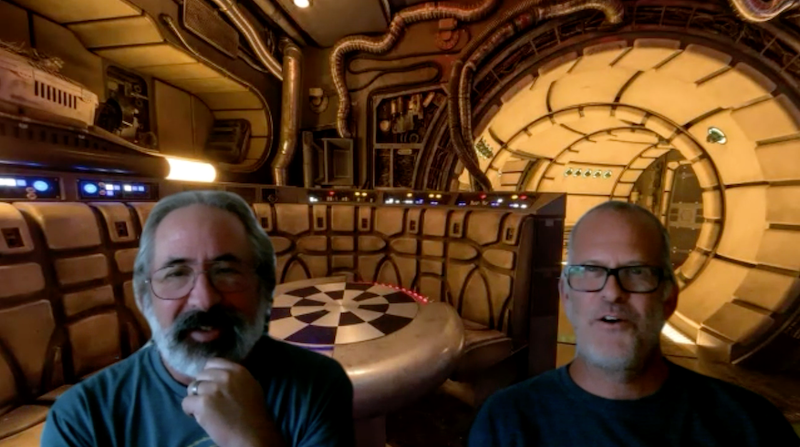
Kevin Cahill and Chip Lenno on a Zoom call less than 2 weeks after their house burned down.
Question: You said you felt supported by the campus community. How so?
Lenno: We’ve often had conversations [about it] between us and amongst friends and members of the LGBTQ community. I came out during my job interview. That was new in the year 2000. CSUMB’s always felt welcoming and supportive.
Cahill: At all levels. The administration, fellow coworkers, and especially students—they were always really accepting.
Lenno: We would walk into the classroom together on the first day and introduce ourselves as a couple. We had gotten married in 2004 in San Francisco. That was voided by the courts. Then in 2008 the California Supreme Court said same sex marriage was legal under the state constitution. We wanted to get married again and [we thought] where do we want to get married? This is the place we met. This is the perfect place. The University Center folks were behind it. The executive chef was all excited about it.
Cahill: It was really cool. We started with cocktails and hors d’oevres. We had a calamari bar and a cheese bar. The chef served lasagna, which was based on my grandmother’s recipe. After dinner we all stood up, went outside, got married, then came back in and had wedding cake. We like the fact that we do things differently at this school. We believe in the way we do things.
Can you describe your house?
Cahill: Our house was built in 1952. It was a Mid-century modern house, designed by the guy who built the house—George Tombleson [of] Tombleson Construction Company. He built it for his own family. There is a guest house 30 yards away from the main house, and a “barbecue room” that shares a roof with the main house.
Lenno: It was a bar.
Cahill: It was a mancave.
Lenno: We think George was influenced [on this house] by the Butterfly House in Carmel.
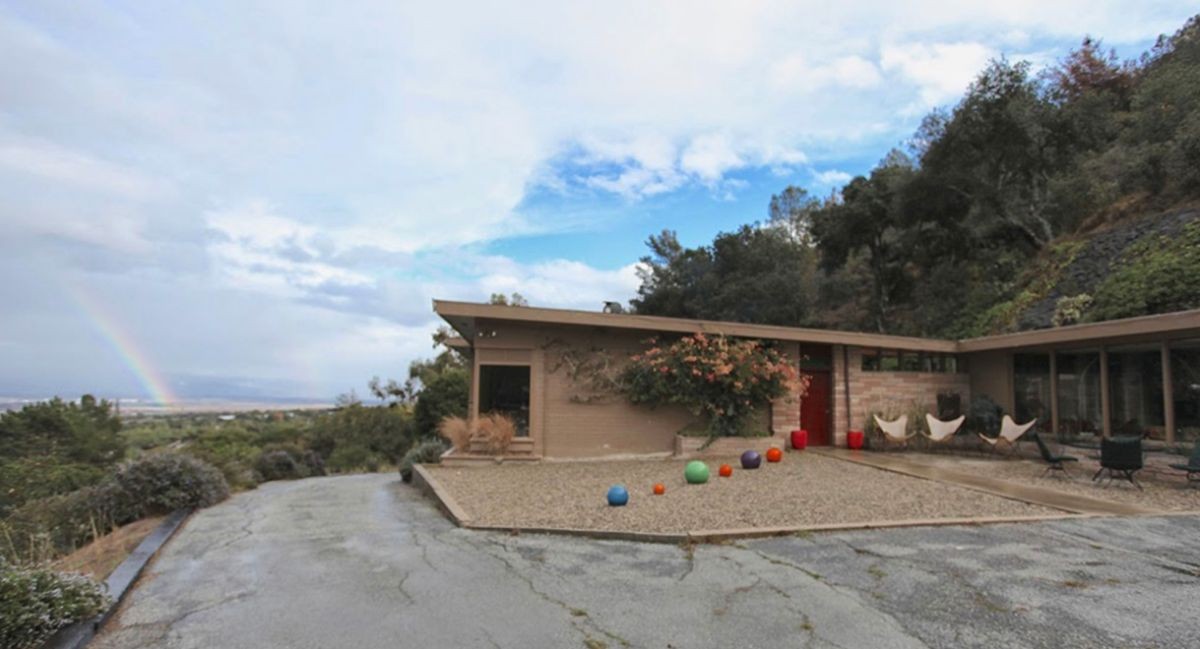
Photo by: Kevin Cahill Chip and Kevin's hillside house overlooking Salinas Valley. The barbecue room is on the right, the living room on the left.
Cahill: I got my MFA from the Cranbrook Academy of Art. It’s famous for its alumni who designed furniture—probably the most famous furniture from the 50s and 60s. Our house is filled with [that] furniture. Charles and Ray Eames. We had a dining room table designed by Eero Saarinen.
Lenno: We’re both in love with Mid-century modern. We’ve spent the 20 years of our lives collecting vintages pieces of that furniture…that we’ve lost. Those are the easy things [to replace]. [We had] Kevin’s grandparents’ shotguns we inherited. A 150-year-old grandfather clock my great-great grandfather carved the case for, that is gone. There’s family photos we’ll never replace, art we had collected over the years.
Cahill: The thing that made our house special was the view. Four acres on the side of a hill, the entire Salinas Valley, from Chualar to Moss Landing, from our living room, kitchen, office. There wasn’t a single day since 2010 that I didn’t look out that window and think “Oh my God, I’m so lucky to live here. I love this place.” We live off River Road in Pine Canyon. The Monterey Zoo is at the bottom of Pine Canyon. It was not uncommon for us to wake up and hear elephants.
Lenno: Watching the magnitude of what Salinas Valley does from that perspective—its produce industry, the growing of food, the rotation of the crops. It gives you a sense of respect of what Salinas Valley does.
When you first heard about a fire, did you think your house might be in danger?
Lenno: No. Sunday morning [Aug. 16], about a quarter-to-four, I got up to get a glass of water. We were in the middle of that heat wave. We had the front door open with the screen door closed. And I could smell smoke. It didn’t smell out of the ordinary [except] why would anybody have a fire going? The lightning had awaken me earlier but I didn’t make the connection between the smell of smoke and fire. The air was quite clear. Across the valley the lights were twinkling. Pretty normal. When we got up the next morning it was already being reported as the River Fire.
When you live in rural areas, anytime there’s a fire you pay attention. Kevin’s cousin lost their home in the [2017 Tubbs Fire in] Santa Rosa. We drove to the bottom of Pine Canyon. You could see the plume of smoke and you could tell that it was a nice dry fire, lots of fuel burning. It was still 10 or 15 acres. Pretty small. I thought “Should we pack a bag?” We were like “nah.” It’s still miles away, it’s not that big. Several hours later, it’s up to 200 acres. That’s a lot of growth in one day.
We were watching [news] reports. I told Kevin, “There’s a bunch of crap in back of the truck from the last camping trip. Let’s clean it out just in case.” We put everything away. I started hooking up the trailer. Then we could see the smoke plume from our house. I said, “Kevin, I think we should pack a couple of bags.” We did. We made sure we had all of our medications. I had taken the suitcases to the truck. Kevin was taking pictures. Then we got the evacuation advisory.
Cahill: I was not anxious. I was confident the fire department—there were so many fire trucks there. They had fire trucks at almost every house above us. The day Chip went up to get the car, they said there were five more trucks coming to our area. We had a fire hydrant on our property. I was confident that the firemen were going to protect our house.
Lenno: When we got the advisory, I wasn’t worried about the grandfather clock, the guns, the art on the wall or any of the other 10,000 objects you have in your house that you want to save. Kevin went into the office and started grabbing some family photos. I did a sweep and grabbed the technology and back up drives with digital photos. At that point the smoke is getting pretty bad so I go back in and grab some deeds, the wedding certificate. I don’t remember what we grabbed at this point.
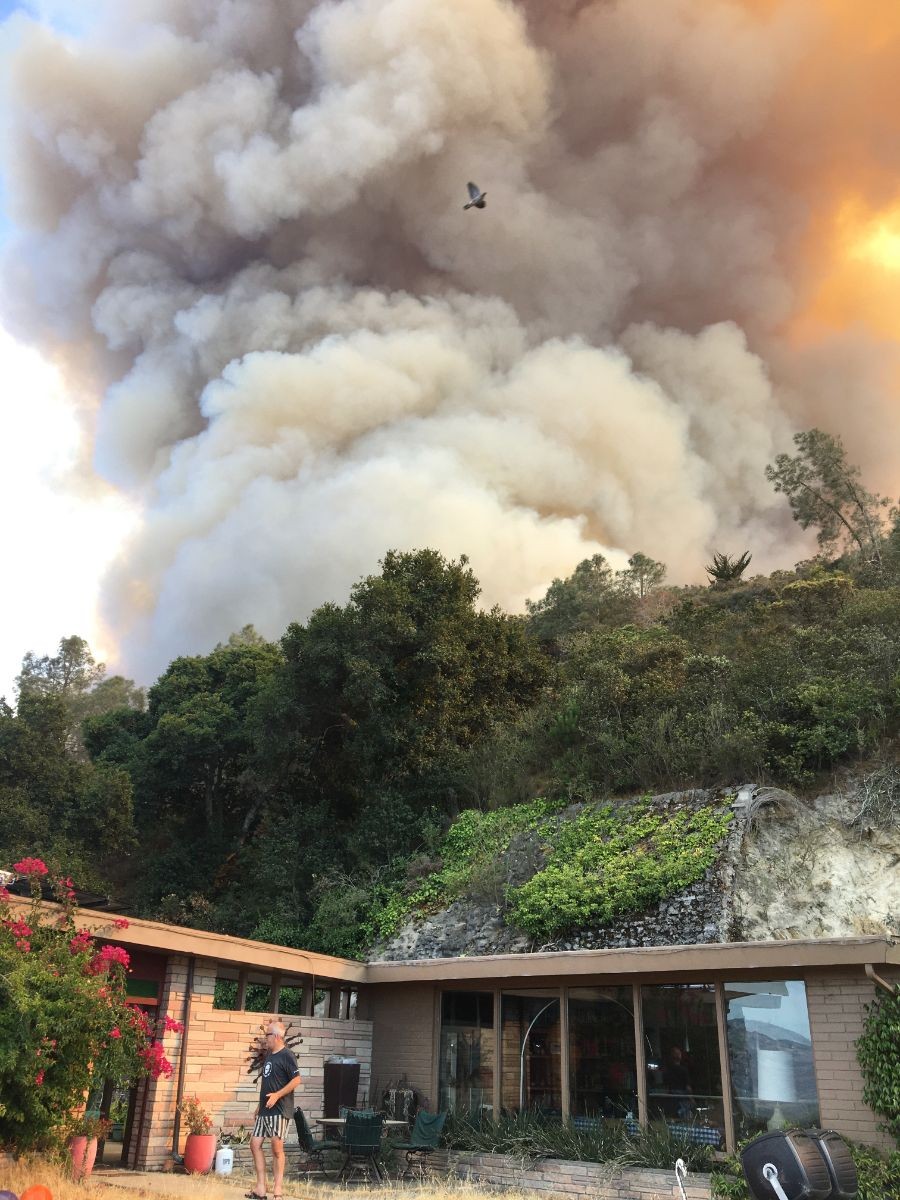
Photo by: Kevin Cahill Chip Lenno during their evacuation.
We have a dog, We got her kennel out into the truck. We got the cat carrier. We didn’t even remember to grab a lot of food for them. Once the pets were secure, 25-30 minutes later, that’s when we got the mandatory evacuation. I ran back into the house and told Kevin we have to go now. It felt like two hours in my head [to get out]. It turns out it was only 20 minutes.
I went back the next day and got the last of our cars and more possessions. I remembered that night there was a portrait of my grandmother that was quite special to my family that we had stored in our closet for safekeeping. I was able to get that and a couple of documents. That was five hours before the house burned. There was no indication that it was going to burn. Firemen had been to the property, had done as much defensive stuff as they could—PG&E had done that too—cut limbs off trees so fire trucks could get through. The prep work CAL-Fire did was amazing. Those people really are heroes.
You left after getting the mandatory evacuation. When did you discover your house had burned down?
Cahill: On Friday [Aug. 21] someone from a couple streets over posted [on Next Door] addresses of two houses that he heard had burned. He posted the address of a house directly below us. Another address of a house below that. But no mention of our house. So we go out on…what day?
Lenno: …it was Friday.
Cahill: Friday…to see how bad our neighbor’s house was, and it was perfect condition.
Lenno: Unscathed. They had a horse pasture. That burned.
Cahill: The other house they mentioned [on Next Door] was intact but the separate garage burned down.
Lenno: Just before 4 o’clock we were able to drive up to check [our house].
Cahill: We were driving up there pretty confident that we still had a house because someone had already posted the addresses of the two places that were lost. And our address hadn’t been posted. We drive past the house that’s supposed to be gone. It’s still there. We drive up the hill, turn the corner. Oh my God. Our house is gone. It…it was tragic.
Lenno: It was like when my dad died. Like when Kevin’s sister passed away. It was like being punched in the gut. The house was so special. We had developed a tradition. For many years, for all the SCD capstone and web production students at end of semester, we would host a big barbecue at the house the week before commencement. Hundreds of our students had been up to visit our home and share it with us.
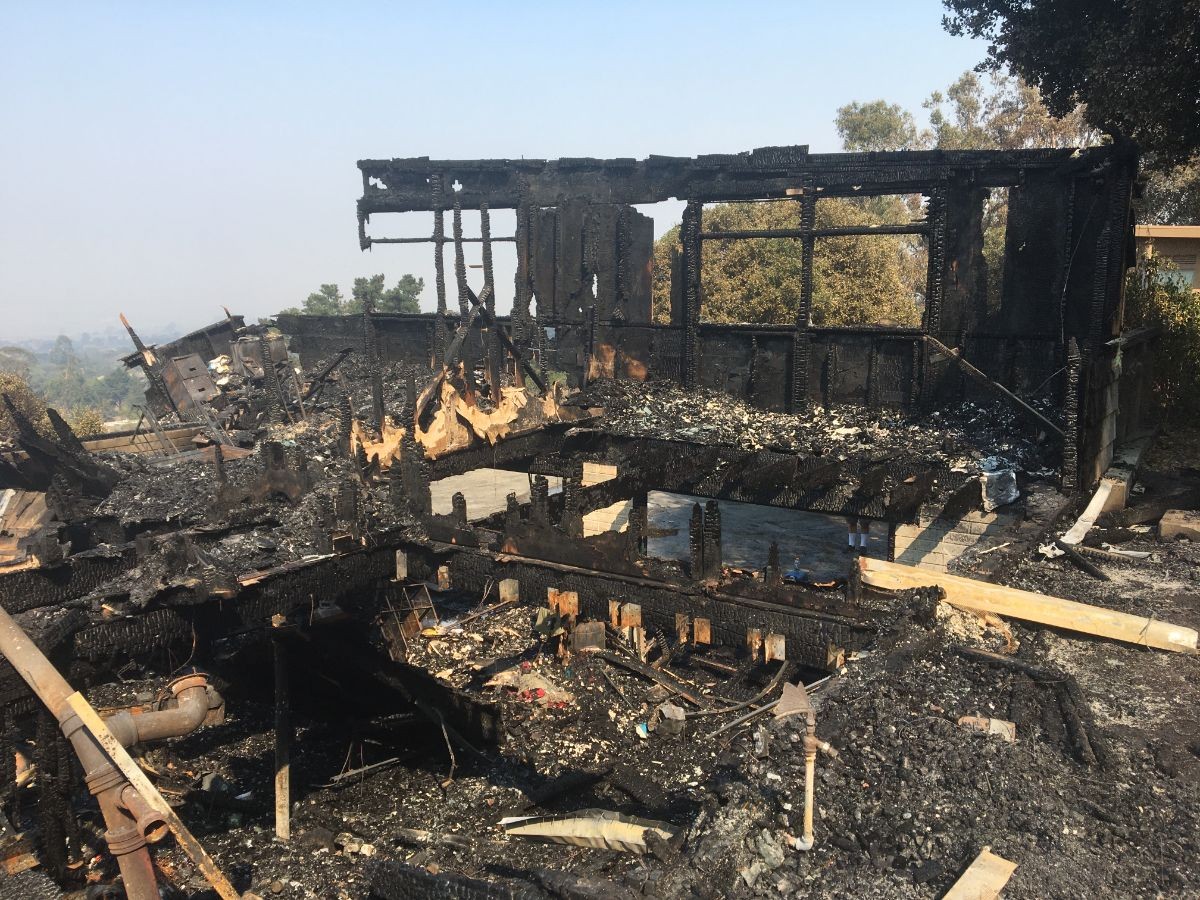
Photo by: Walter Ryce The gutted interior of the house, with an empty space in the middle that used to be the garage.
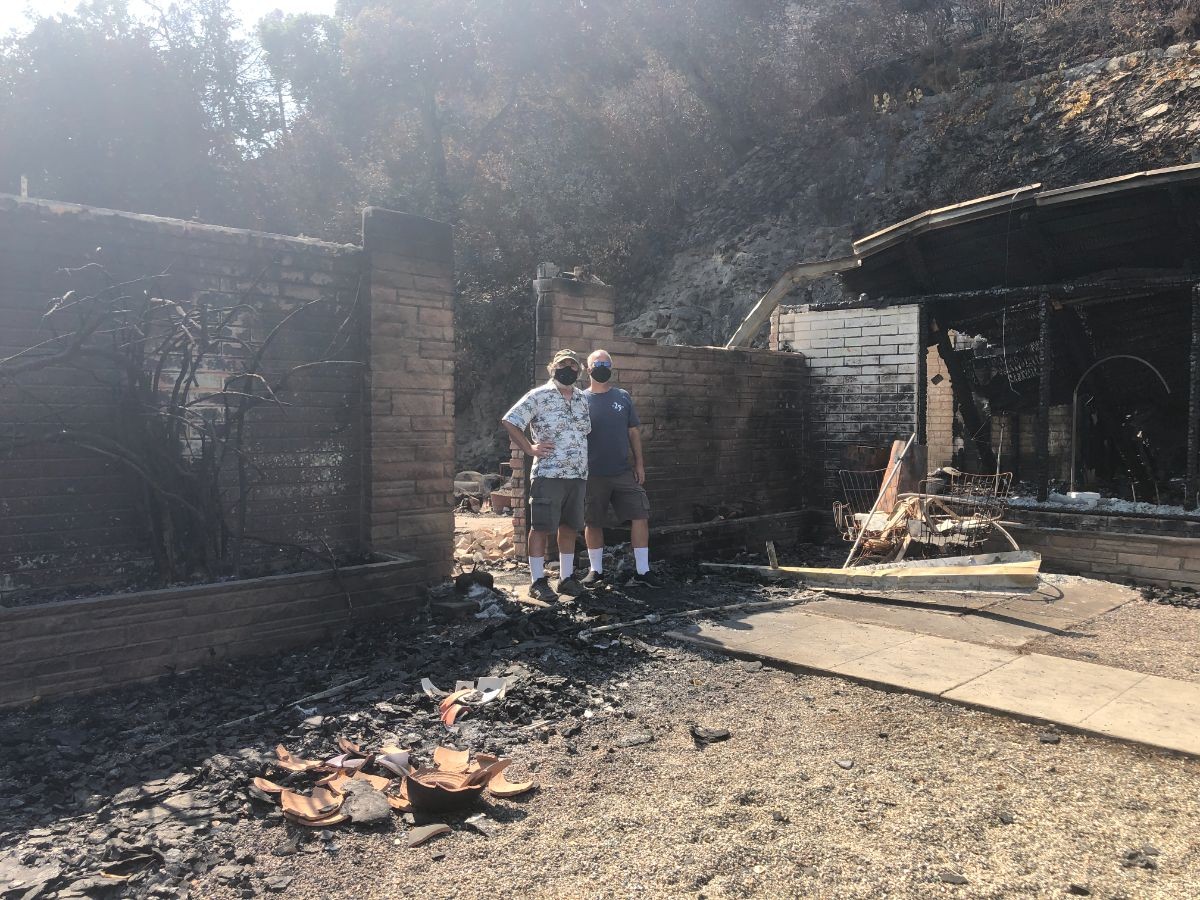
Kevin and Chip at the front of their house after the fire
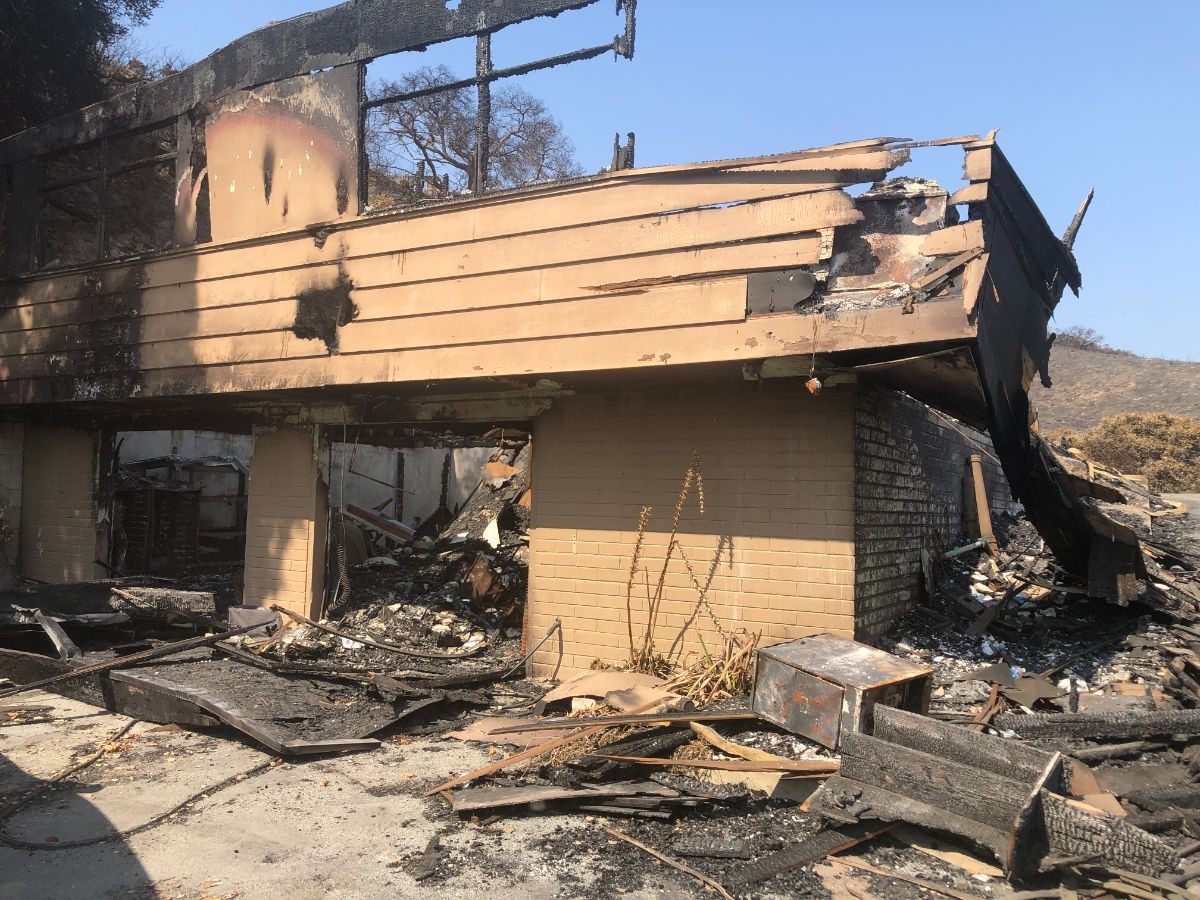
The former garage, downstairs; upstairs from that was the office and kitchen.
Cahill: There’s video that shows a fire truck at our house fighting the fire. I have to let that go, if I’m going to heal and get through this. What’s made it so hard is that I was so confident [our house was safe]. Now…I have no house.
Lenno: But we will.
Cahill: We will. We hired Tombleson Construction, and they will be rebuilding the house. It’s nice to know they have an emotional connection.
Lenno: They also did the Otter Express building renovation, and Building 71.
Cahill: We’ll love designing it. It’s going to be a rewarding experience to come up with a house that honors the original vision and serves us even better. When the house gets rebuilt, we’ll be just about to retire. We’re designing the house for two old guys.
Lenno: Speak for yourself. I’m not old.
Cahill: Chip was saying that the hallways have to be wide to get our wheelchairs through. There was a pool in the back yard, but it was empty and covered with a deck. We’re going to refurbish the pool so we have a place to swim, but we’ll also have a large amount of water in our back yard in case we have another fire.
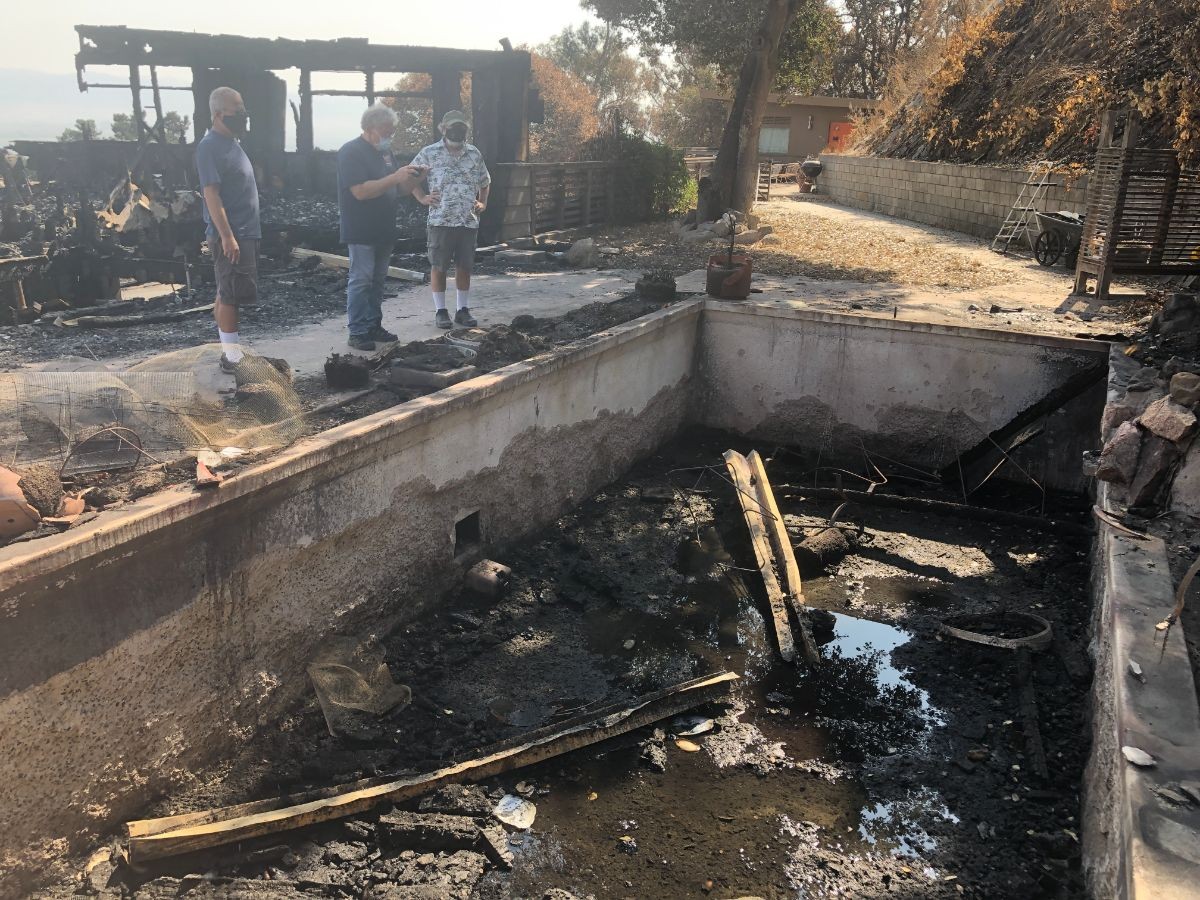
The pool that was empty and covered.
Lenno: I don’t think it’ll be built with wood this time. No wood. I don’t think they’ll let us. We’ll want to work with the appropriate county and FEMA agencies to make the property is more defensible. Because I certainly don’t want to have to go through this again. Once in a lifetime is plenty.
Kevin’s cousin lost their home [in the Tubbs Fire]. We were on the phone with them, and sharing their experiences has been helpful. If there’s other people who read about us and have lost their homes, it was helpful to talk to someone who’s been through it, and know what we’re feeling and know what to expect. There’s things you won’t remember now but will remember two years from now that you lost and it will make you cry. Knowing more what to expect makes it easier. We tend to share stories. It’s how humans communicate best I think.
What are the things I would be devastated if I never could have them again? Now, there’s all sorts of “Holy crap, why didn’t I grab that thing?” At the end of the day there’s so many of those objects in your home. It’s not something you can be prepared for unless you do it when there’s absolutely nothing going on. Go through each room and make a list. So if something happens, “Here are the top 5 things to take out of this room.” We’ve been joking we’re going to write a book—How to Survive a Wildfire Before it Happens. [Laughs]. We knew to pack a bag, grab medication. Once you get past that high level of things, then it broke down. In the heat of the moment…we should have written it down someplace: “If we have to evacuate, go to the barbecue room and grab this thing.” Kevin had a first edition of an biography of Vallejo written by his great-great granddaughter. That was something we should have grabbed. Things with family association. If I could tell others what to do, I would say make a list. Prioritize it. Be methodical about it. It’s easy to get shaken up when being told to abandon your home in the middle of a wildfire.
Where are you two living now?
Lenno: We landed in one of the furnished guest units in East campus the first full day of evacuation. We spent the first night in our trailer parked alongside Jeff McCall’s house. He gave us internet and power. There were several other evacuees who used on-campus housing. A former student [upstairs here] has been bringing us food. Nate Ju lives upstairs. He brought us a loaf of bread he baked. [Someone offered] a blender for margaritas. We’ve had offers of furniture and clothes and places to stay. The folks from Human Resources have reached out. Everyone from President Ochoa on down has reached out us.
Cahill: And students.
Lenno: And students. It has been beautiful to watch. We have an amazing community at CSUMB.
Cahill: I’m not at all surprised by the outpouring of support. That’s CSUMB.
Lenno: It’s been a rollercoaster. I’m still waking up in the middle of the night remembering things we will never see again. We lost a lot of art and antiques, family photos, all of the stuff everybody thinks about losing when you think of losing your home. We will grieve those losses for the rest of our lives. But at the same time we feel fortunate. We’re safe, our pets are safe, our family is safe. We’re together. We readily found a place to live because the campus had housing we could drop into during the crisis, and we’ll be here while we’re rebuilding. When we realized that, things seemed so right. Kevin and I met and fell in love at CSUMB. We got married in the University Center in 2008. CSUMB is a very special place for us. We spent our first 10 years together living on campus. So coming back here while we rebuild our home, it just feels right.
Cahill: The timing is really bizarre because this happened…
Lenno: …72 hours…
Cahill: …before school started. I have never been more anxious about the beginning of a semester than I was this semester. I don’t have a lot of experience teaching via Zoom. My classes have been going really, really well. These kids have spent a lot of time in Zoom classes and are super fluent in the Google suite. They were in breakout rooms this morning. They were laughing, so engaged. This is going to be a really fun, productive semester. That’s been very helpful knowing there’s something else I can think about besides my house being gone.
Lenno: There are moments I’m numb. You get to the end of the day and you’re just spent. It’s 2020. When all this is over and we’re all back together, we’re all going to need PTSD therapy—whether you lost your home or didn’t—because of what we’ve all been through. Getting locked up all these months, being worried about getting Covid-19, finding out what our lives are going to be like online.
We know there’s so many people out there, in the Carmel and Santa Cruz fires and elsewhere, who don’t have the support and resources we do. One of the folks who lost their home in Cachaugua is a friend of mine from high school. They had five minutes to flee and he lost all his instruments. They don’t have the same level of insurance we have. We have the mechanisms at our disposal to rebuild our lives. There a lot of people out there who don’t. Those are the people who I worry about.
Cahill: We’re getting ready to sign a lease. A lot of people don’t have that. Even though we’ve lost everything we’re okay. We’ll get through this.
September is Emergency Preparedness Month. Fire season typically runs May through October. Prepare for emergencies such as fire, extreme weather, earthquake and more by visiting Ready.gov.
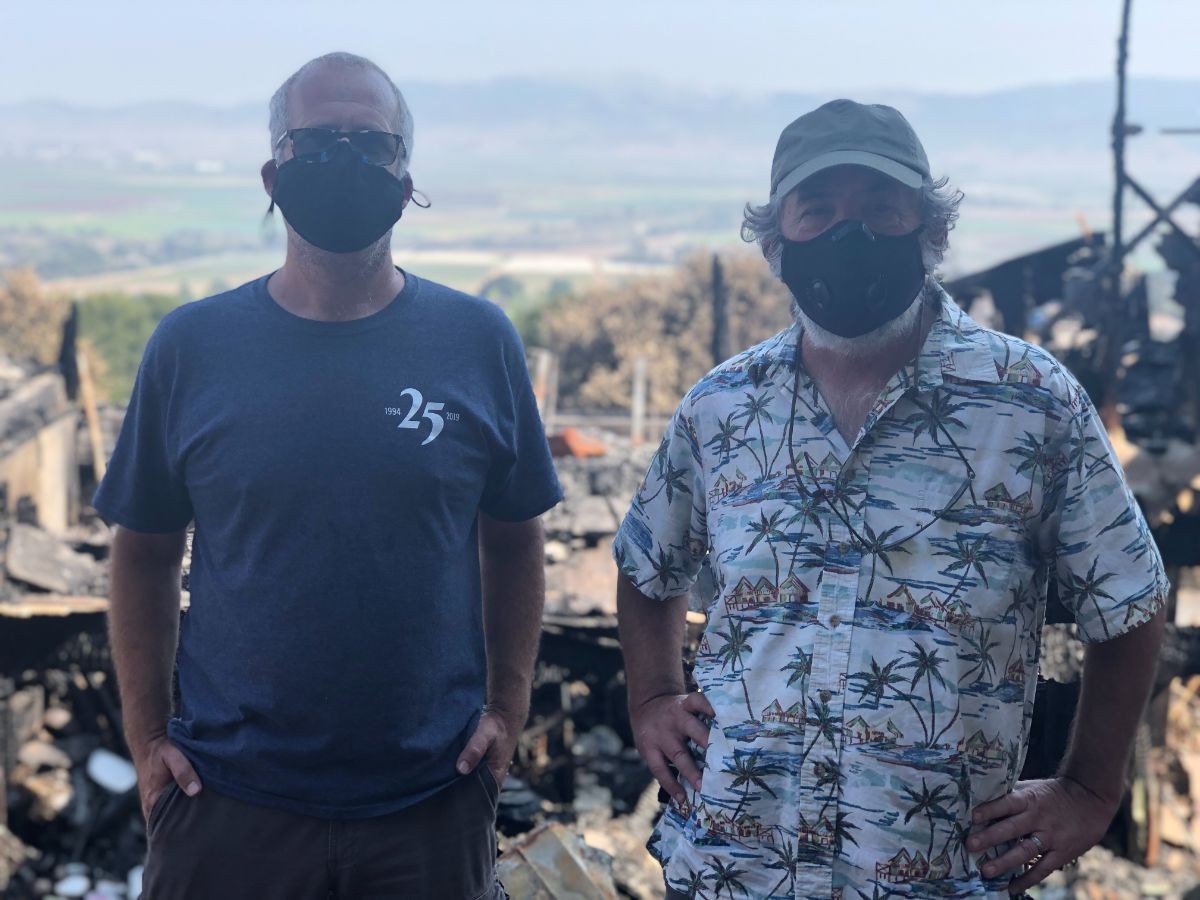
Photo by: Walter Ryce Chip and Kevin signed a lease on a temporary house, and are designing their new home on the site of their former home.